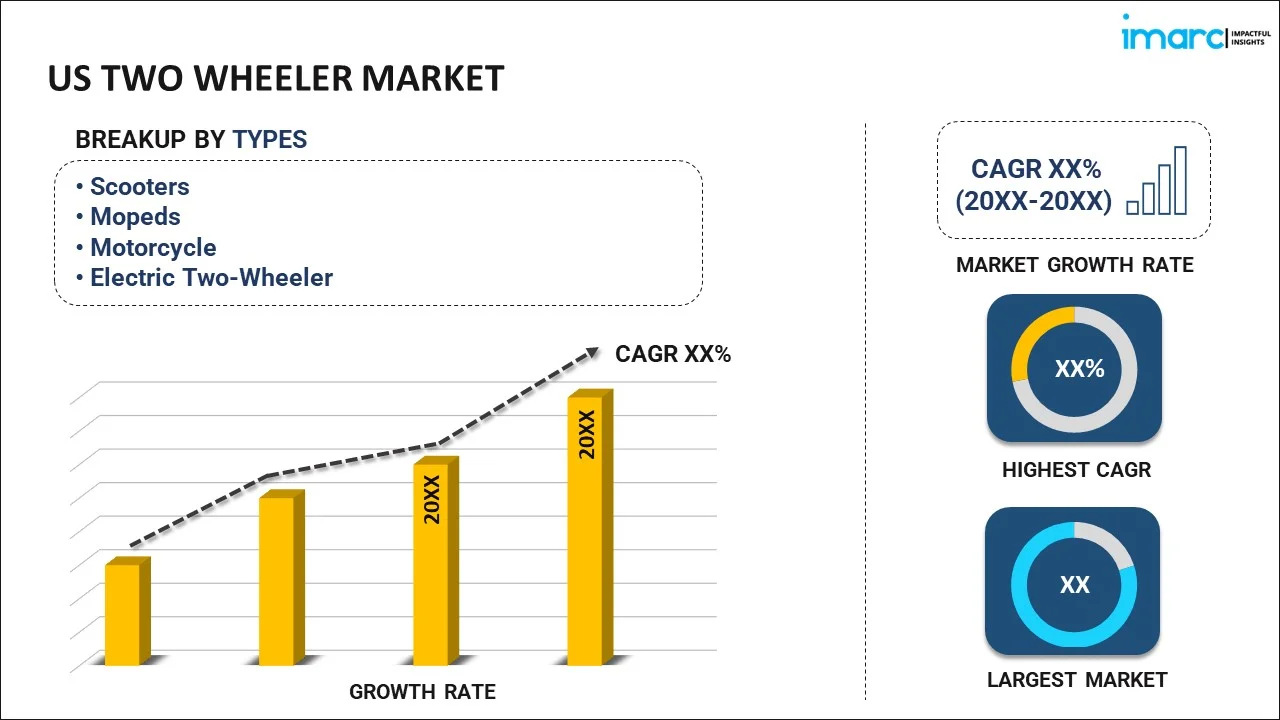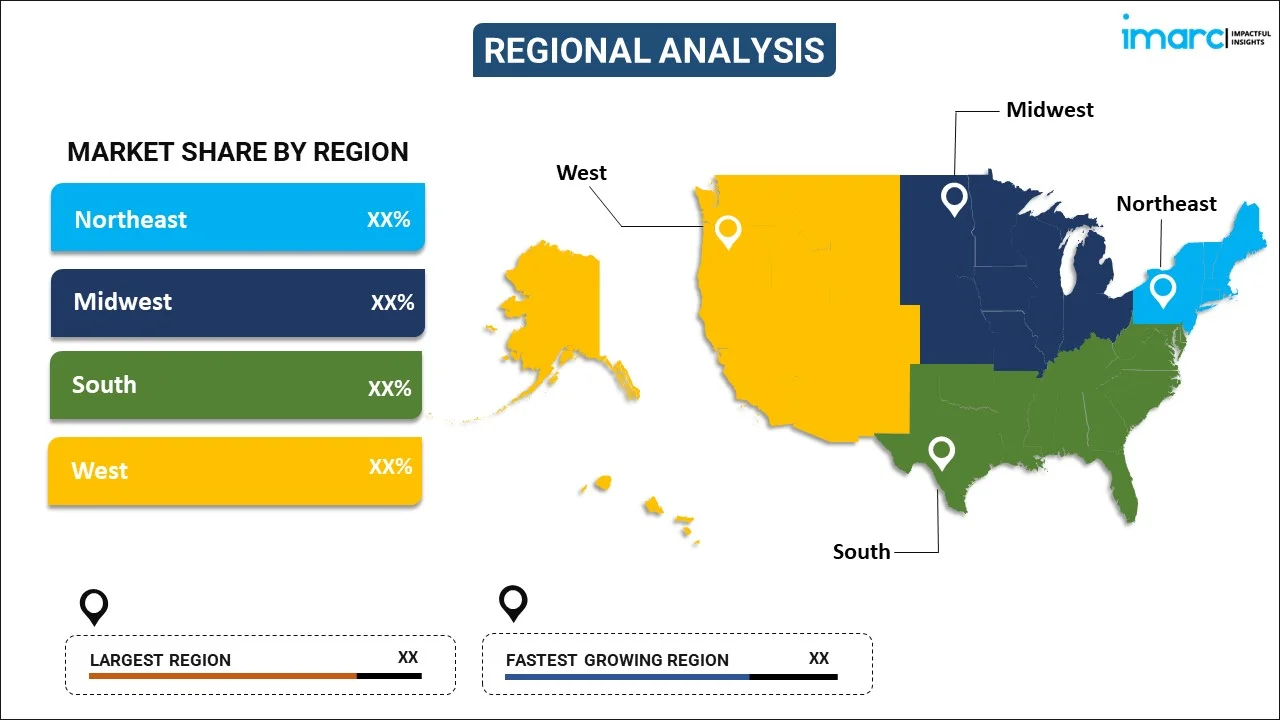
US Two Wheeler Market Report by Type (Scooters, Mopeds, Motorcycle, Electric Two-Wheeler), Technology (ICE, Electric), Transmission (Manual, Automatic), Engine Capacity (<100cc, 100-125cc, 126-180cc, 181-250cc, 251-500cc, 501-800cc, 801-1600cc, >1600cc), Fuel Type (Gasoline, Petrol, Diesel, LPG/CNG, Battery), End User (Personal, Commercial), Distribution Channel (Offline Channels, Online Channels), and Region 2025-2033
Market Overview:
US two wheeler market size reached USD 34.2 Billion in 2024. Looking forward, IMARC Group expects the market to reach USD 40.6 Billion by 2033, exhibiting a growth rate (CAGR) of 1.92% during 2025-2033. The increasing innovations in technology, such as the development of electric two-wheelers, connected features, and improved safety systems, that can attract consumers looking for modern and advanced transportation options, are driving the market.
|
Report Attribute
|
Key Statistics
|
|---|---|
|
Base Year
|
2024 |
|
Forecast Years
|
2025-2033
|
|
Historical Years
|
2019-2024
|
| Market Size in 2024 | USD 34.2 Billion |
| Market Forecast in 2033 | USD 40.6 Billion |
| Market Growth Rate (2025-2033) | 1.92% |
A two-wheeler refers to a type of vehicle that is powered by a two-stroke or four-stroke engine and is designed to be ridden on two wheels. These compact and maneuverable vehicles are commonly known as motorcycles, scooters, or mopeds. Two-wheelers are popular for their agility, fuel efficiency, and ease of navigation through congested traffic. Motorcycles, with their powerful engines and sleek designs, are favored by enthusiasts for their speed and performance. Scooters, on the other hand, are known for their convenience, especially in urban areas, offering an accessible and economical mode of transportation. Two-wheelers are widely used for commuting, leisure riding, and even professional racing, making them an integral part of the transportation landscape. Their versatility and fuel efficiency contribute to their widespread adoption, catering to a diverse range of riders and preferences.
US Two Wheeler Market Trends:
The two-wheeler market in the US is experiencing robust growth due to several key drivers. Firstly, the rising demand for cost-effective and fuel-efficient transportation has propelled the market forward. Additionally, the increasing urbanization and congestion in cities have prompted individuals to opt for nimble and agile two-wheelers as convenient means of commuting. Moreover, the surge in disposable income has elevated the purchasing power of consumers, fostering a heightened interest in owning personal vehicles, particularly two-wheelers. Furthermore, the growing awareness of environmental concerns has led to a shift towards eco-friendly modes of transportation, boosting the market for electric two-wheelers. In tandem, technological advancements in the industry, such as improved fuel efficiency, safety features, and connectivity options, have attracted a broader consumer base. The ease of maneuverability and reduced parking space requirements further contribute to the popularity of two-wheelers in congested urban areas. In conclusion, a confluence of factors, including economic empowerment, environmental consciousness, and technological progress, collectively drive the thriving two-wheeler market. As these trends persist and evolve, the regional market is poised for sustained growth, with manufacturers continually innovating to meet the diverse needs and preferences of the expanding consumer base.
US Two Wheeler Market Segmentation:
IMARC Group provides an analysis of the key trends in each segment of the market, along with forecasts at the country level for 2025-2033. Our report has categorized the market based on type, technology, transmission, engine capacity, fuel type, end user, and distribution channel.
Type Insights:

- Scooters
- Mopeds
- Motorcycle
- Electric Two-Wheeler
The report has provided a detailed breakup and analysis of the market based on the type. This includes scooters, mopeds, motorcycle, and electric two-wheeler.
Technology Insights:
- ICE
- Electric
A detailed breakup and analysis of the market based on the technology have also been provided in the report. This includes ICE and electric.
Transmission Insights:
- Manual
- Automatic
The report has provided a detailed breakup and analysis of the market based on the transmission. This includes manual and automatic.
Engine Capacity Insights:
- <100cc
- 100-125cc
- 126-180cc
- 181-250cc
- 251-500cc
- 501-800cc
- 801-1600cc
- >1600cc
A detailed breakup and analysis of the market based on the engine capacity have also been provided in the report. This includes <100cc, 100-125cc, 126-180cc, 181-250cc, 251-500cc, 501-800cc, 801-1600cc, and >1600cc.
Fuel Type Insights:
- Gasoline
- Petrol
- Diesel
- LPG/CNG
- Battery
The report has provided a detailed breakup and analysis of the market based on fuel type. This includes gasoline, petrol, diesel, LPG/CNG, and battery.
End User Insights:
- Personal
- Commercial
A detailed breakup and analysis of the market based on the end user have also been provided in the report. This includes personal and commercial.
Distribution Channel Insights:
- Offline Channels
- Online Channels
The report has provided a detailed breakup and analysis of the market based on distribution channel. This includes offline channels and online channels.
Regional Insights:

- Northeast
- Midwest
- South
- West
The report has also provided a comprehensive analysis of all the major regional markets, which include Northeast, Midwest, South, and West.
Competitive Landscape:
The market research report has also provided a comprehensive analysis of the competitive landscape. Competitive analysis such as market structure, key player positioning, top winning strategies, competitive dashboard, and company evaluation quadrant has been covered in the report. Also, detailed profiles of all major companies have been provided.
US Two Wheeler Market Report Coverage:
| Report Features | Details |
|---|---|
| Base Year of the Analysis | 2024 |
| Historical Period | 2019-2024 |
| Forecast Period | 2025-2033 |
| Units | Billion USD |
| Scope of the Report | Exploration of Historical Trends and Market Outlook, Industry Catalysts and Challenges, Segment-Wise Historical and Future Market Assessment:
|
| Types Covered | Scooters, Mopeds, Motorcycle, Electric Two-Wheeler |
| Technologies Covered | ICE, Electric |
| Transmissions Covered | Manual, Automatic |
| Engine Capacities Covered | <100cc, 100-125cc, 126-180cc, 181-250cc, 251-500cc, 501-800cc, 801-1600cc, >1600cc |
| Fuel Types Covered | Gasoline, Petrol, Diesel, LPG/CNG, Battery |
| End Users Covered | Personal, Commercial |
| Distribution Channels Covered | Offline Channels, Online Channels |
| Regions Covered | Northeast, Midwest, South, West |
| Customization Scope | 10% Free Customization |
| Post-Sale Analyst Support | 10-12 Weeks |
| Delivery Format | PDF and Excel through Email (We can also provide the editable version of the report in PPT/Word format on special request) |
Key Questions Answered in This Report:
- How has the US two wheeler market performed so far and how will it perform in the coming years?
- What has been the impact of COVID-19 on the US two wheeler market?
- What is the breakup of the US two wheeler market on the basis of type?
- What is the breakup of the US two wheeler market on the basis of technology?
- What is the breakup of the US two wheeler market on the basis of transmission?
- What is the breakup of the US two wheeler market on the basis of engine capacity?
- What is the breakup of the US two wheeler market on the basis of fuel type?
- What is the breakup of the US two wheeler market on the basis of end user?
- What is the breakup of the US two wheeler market on the basis of distribution channel?
- What are the various stages in the value chain of the US two wheeler market?
- What are the key driving factors and challenges in the US two wheeler?
- What is the structure of the US two wheeler market and who are the key players?
- What is the degree of competition in the US two wheeler market?
Key Benefits for Stakeholders:
- IMARC’s industry report offers a comprehensive quantitative analysis of various market segments, historical and current market trends, market forecasts, and dynamics of the US two wheeler market from 2019-2033.
- The research report provides the latest information on the market drivers, challenges, and opportunities in the US two wheeler market.
- Porter's five forces analysis assist stakeholders in assessing the impact of new entrants, competitive rivalry, supplier power, buyer power, and the threat of substitution. It helps stakeholders to analyze the level of competition within the US two wheeler industry and its attractiveness.
- Competitive landscape allows stakeholders to understand their competitive environment and provides an insight into the current positions of key players in the market.
Need more help?
- Speak to our experienced analysts for insights on the current market scenarios.
- Include additional segments and countries to customize the report as per your requirement.
- Gain an unparalleled competitive advantage in your domain by understanding how to utilize the report and positively impacting your operations and revenue.
- For further assistance, please connect with our analysts.
 Inquire Before Buying
Inquire Before Buying
 Speak to an Analyst
Speak to an Analyst
 Request Brochure
Request Brochure
 Request Customization
Request Customization




.webp)




.webp)












